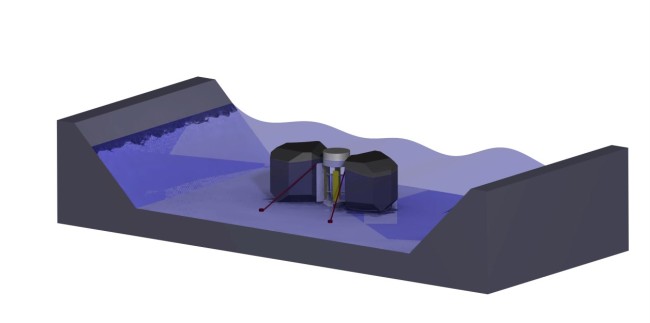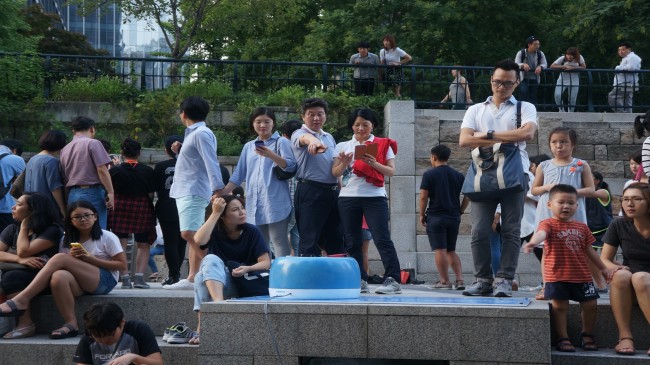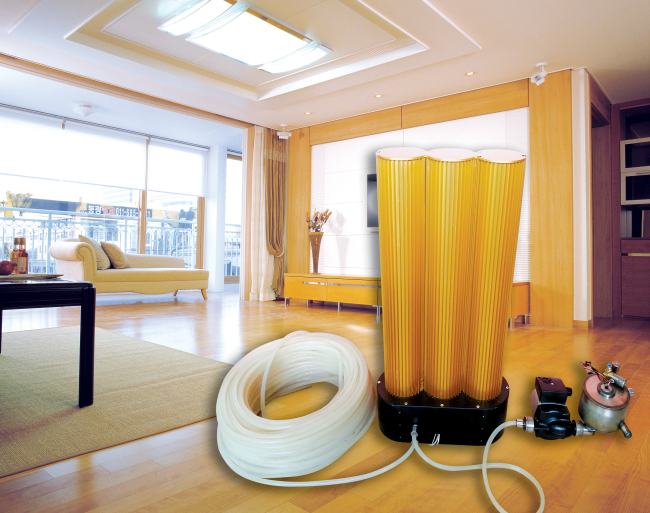Portable power generation leads green innovation charge
By Kim Yon-sePublished : Oct. 8, 2014 - 21:13
The following is the third in a series of articles on the creative green economy, which focuses on generating new growth engines and was initiated by the Park Geun-hye administration and the Ministry of Environment. ― Ed.
South Korea uses solar or wind power for only three to four hours a day on average despite the high demand for renewable energy worldwide, according to environmental technology researchers.
They stress that industries should pay more attention to the country’s geographical features ― its many mountains, valleys, streams and rivers ― in order to generate more eco-friendly alternative energy.
The latest model, a small-scale hydropower generation facility, minimizes negative effects on the environment as it produces electricity without dams or barrages. It requires only simple turbines.
This portable water stream power system was given an award by the Korea Environmental Industry and Technology Institute.
South Korea uses solar or wind power for only three to four hours a day on average despite the high demand for renewable energy worldwide, according to environmental technology researchers.
They stress that industries should pay more attention to the country’s geographical features ― its many mountains, valleys, streams and rivers ― in order to generate more eco-friendly alternative energy.
The latest model, a small-scale hydropower generation facility, minimizes negative effects on the environment as it produces electricity without dams or barrages. It requires only simple turbines.
This portable water stream power system was given an award by the Korea Environmental Industry and Technology Institute.

The product, which was developed by the venture start-up Innomad, can function in a slow-flowing stream for 24 hours a day. It uses rotating turbines that are specially designed not to harm aquatic animals.
“Smartphones, notebooks and other portable electric appliances can be powered in outdoor environments using the product,” said KEITI researcher Seok Sung-woo.

One such mobile-device recharging station set up by Innomad in cooperation with Seoul City at Cheonggyecheon Stream in downtown Seoul is gaining popularity among citizens. The city also plans to provide citizens with phone- and tablet PC-recharging booths using solar energy around Gwanghwamun.
Another innovative device, a high-efficiency vacuum heating system, also drew wide attention during a recent green technology fair hosted by the state-run KEITI.
“An ordinary vacuum heating device running at only 100 watts per hour generates steam and heats the circulating water through a pipe. The new pipe is designed for high-efficiency thermal transfer,” Seok said.
Water droplets generated via a temperature difference are dropped in the jet nozzle, heated and then transformed into steam again by the heating device.

This cycle takes place inside three vacuum tubes. The vacuum pressure can be controlled by a re-vacuum valve if the vacuum effect is exhausted. This product, running at 300 watts, can operate in a 5-square-meter room, and can serve as a floor heater as well.
A missing-phone locating service has also been recognized during the fair for its use of creative technology.
The penetration rate of mobile phones in South Korea exceeded 100 percent as of 2010, while it was second in the world in terms of smartphone use with a rate of 73 percent as of 2013.
In proportion to the high usage rate, data shows, about 800,000 mobile phones are lost every year ― most of them expensive smartphones.
The locating service utilizes information technology and the logistics industry to recover mobile phones, with appropriate compensation for those who find the devices.
The service creates a win-win situation for those involved. The process is simple: the finder reports the phone to the nearest convenience store, while the person who lost the phone reports the loss to a registered mobile telecommunication company.
This is expected to contribute not only to the recovery of lost items, but also to conservation of resources.
Meanwhile, an IT-integrated product offers “social innovation for neighborhood growth.”
“Like other nations, Korea faces the critical issue of urban concentration and an economic recession in rural areas,” said Jung Young-do, a researcher at the sustainability strategy office of KEITI.
Jung said that this sort of service, dubbed “social innovation for neighborhood growth,” utilizes large cultivation areas in rural locations and farmers who are available to work to provide a new service that targets urban citizens.
A consumer requests a service provider to cultivate vegetables using eco-friendly methods for his or her family. Once the harvesting is complete, the products can be delivered via courier, or consumers can visit the site directly.
Moreover, family unity can be strengthened by participating in various rural programs, as well as purchasing eco-friendly agriculture products in season. This service aims to provide a healthy outlet for urban citizens, as well as economic activation for local communities.
As a public institute affiliated with the Ministry of Environment, KEITI has set the paradigm: “Green economy plus creative economy equals creative green.”
One of KEITI’s missions is to support eco-design in industry through the Eco-Design Project.
The project focuses on innovation rather than simple improvement in the day-to-day environmental performance of existing products, researchers stressed.
They said that innovation refers to a differentiated technology and business model, which can transform the lifestyle of consumers in an eco-friendly direction.
In a similar vein, the Ministry of Environment ― under a national goal to join the world’s top 10 green industry powerhouses by 2020 ― said it would sharply increase and diversify its support programs in collaboration with a variety of state-controlled agencies.
By Kim Yon-se (kys@heraldcorp.com)










![[Robert J. Fouser] Social attitudes toward language proficiency](http://res.heraldm.com/phpwas/restmb_idxmake.php?idx=644&simg=/content/image/2024/05/16/20240516050799_0.jpg&u=)
![[Graphic News] How much do Korean adults read?](http://res.heraldm.com/phpwas/restmb_idxmake.php?idx=644&simg=/content/image/2024/05/16/20240516050803_0.gif&u=)





![[Herald Interview] Byun Yo-han's 'unlikable' character is result of calculated acting](http://res.heraldm.com/phpwas/restmb_idxmake.php?idx=652&simg=/content/image/2024/05/16/20240516050855_0.jpg&u=)
